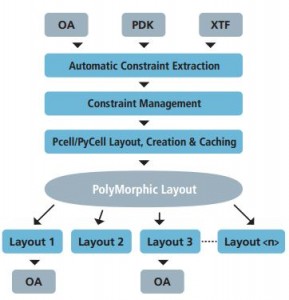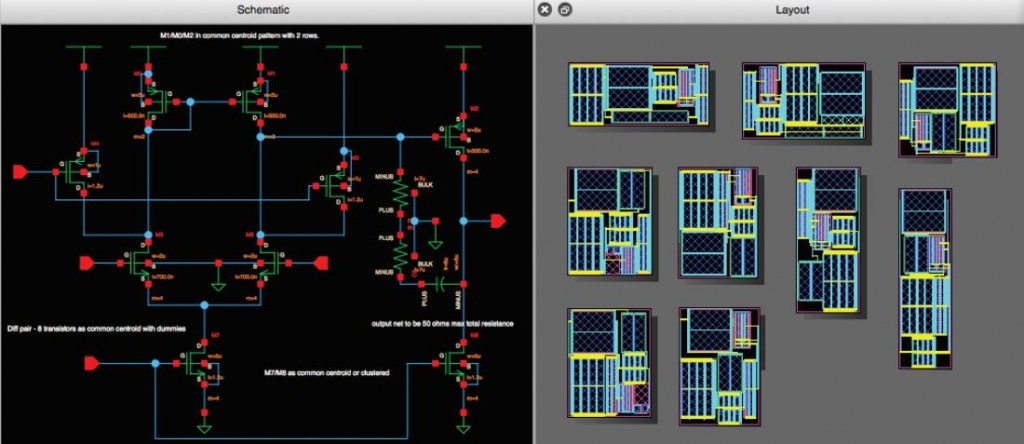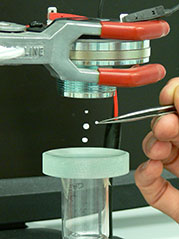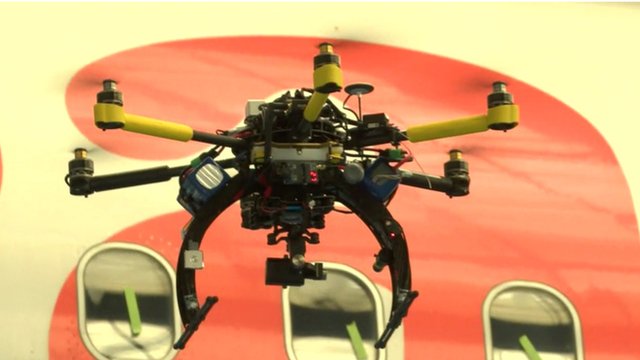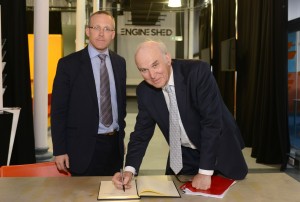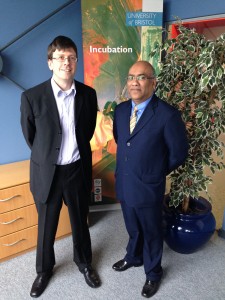Ensigma’s 802.11ac WiFi IP cores gain chip traction
There is growing market traction for the Ensigma Series4 ‘Explorer’ radio processor unit (RPU) cores designed in Chepstow as more companies integrate 802.11ac WiFi, Bluetooth 4.1 and other connectivity into their Systems-on-Chips (SoCs).
New customers for the Ensigma WiFi/Bluetooth combo IP cores from Imagination Technologies include Ineda, Toshiba, Toumaz and multiple fabless companies from Korea and China including Rockchip and others from around the world who will be announced publicly at a later time. Among the target applications are streaming media devices, tablets, wearables, IoT devices and standalone WiFi combo chips. The new Ensigma WiFi licensees join the growing Ensigma RPU customer base, which also includes Qualcomm, STMicroelectronics, S2-Tek, Frontier Silicon, Orca Systems and others.
“Moving forward, virtually every device will be connected,” said Martin Woodhead, EVP for Ensigma Communications at Imagination. “To address this, the Ensigma RPU offers the flexibility to design for a range of connectivity and broadcast standards using just one on-chip radio system, so customers can create one design for multiple markets and also have a built-in roadmap for emerging standards. With our end-to-end connectivity solutions including RF, baseband, firmware, software, support and certifications, Imagination is uniquely positioned to help customers address new market opportunities quickly and cost-effectively.”
Imagination has a graphics hardware and software design centre in Bristol as well as the radio design team in Chepstow. The company’s program of WiFi Alliance certifications ensures interoperability. Imagination has recently achieved WiFi Alliance certification for Miracast and Passpoint, adding to a growing list of certifications including WiFi CERTIFIED, WiFi Direct, WPA, WPA2, WMM and WiFi Protected Setup.
The Ensigma Series4 RPUs provide a unique universal and highly scalable solution for integrating global connectivity and broadcast communications capabilities into SoCs. By combining the latest software programmable radio techniques with a multi-processor architecture, a wide range of communications standards are fully supported. The flexible hardware architecture of Ensigma Series4 RPUs means that the engine can be easily scaled to address everything from the smallest most cost-sensitive embedded connected processors to the most advanced connected smart TVs and tablets targeting global markets.
Ensigma RPUs support all key standards for connectivity including 802.11a/b/g, 802.11n with up to 4×4 MIMO, 802.11ac with up to 2×2 MIMO, as well as Bluetooth. They also enable global TV products supporting DVB-T2, DVB-T, ISDB-T, ATSC, GB20600-2006 (CTTB), DVB-S2, DVB-S, ISDB-S, DVB-C, J.83B, ISDB-C; analogue TV; mobile TV including T-DMB, 1-Seg ISDB-T; and broadcast radio standards including DAB/DAB+, HD Radio, 3-seg ISDB-T, ISDB-Tmm and FM.
Related articles
CSR expands in Bristol with new R&D centre
Cambridge Silicon Radio (CSR) has opened a new Research and Development facility in Bristol to drive further innovation in WiFi technology.
The new site, opened today, is staffed by 33 engineers from a wide range of companies in the area such as ST, Nokia and Imagination Technologies and from all around the world, including India, Italy, Spain and the Czech Republic.
“We were building a WiFi team in Bristol but we needed a step change in capability,” said Joep van Buerden, CEO of CSR at the opening (below). “We had the opportunity to acquire the WiFi team lock stock and barrel from ST-Ericsson 16 months ago but then we discovered how good a place Bristol was. There is a steady supply of graduates from the university and leading companies around with a vibrant community of engineers with all sorts of expertise.”
Since the opening of CSR’s original R&D site at the Bristol & Bath Science Park in 2012, the size of the team has grown to 33 employees and CSR expects to continue this expansion. The new R&D facility, at Almondsbury in Bristol, will better support the needs of the existing team and enable growth over the coming years.
This expansion will create a number of job opportunities in the local area, especially for graduates from South West universities. “We have some spare capacity but I could very easily see this office growing further,” said van Beurden.
“At CSR, we’re passionate about developing cutting-edge technology that helps our customers turn great ideas into market leading products, and to do that we need to invest strategically in R&D,” said Anthony Murray, Senior Vice President, Business Group at CSR. “That’s why we’re opening this new, larger facility in Bristol. Bristol has a vibrant technology scene and with high quality universities that are developing the next generation of engineering talent on our doorstep it is a great place to expand our R&D capabilities.”
Related articles
SETsquared named best university business incubator in Europe
SETsquared has been ranked as the top university business incubator in Europe and second best in the world.
The ranking, published by the University Business Incubator (UBI) Index, places SETsquared as one of the world’s leading three incubators, ahead of SCUT Science Park at South China University of Technology and just behind number one, The Rice Alliance for Technology and Entrepreneurship at Rice University Houston.
“SETsquared did really well on our Global Benchmark and beat numerous business incubators based at top universities,” said Dhruv Bhatli, Co-founder and Director of Research at UBI Index said. “They are one of the best incubation places in the world and certainly the best in Europe, as evidenced from their performance on our global benchmark. It is an outstanding business incubator that provides exceptional quality to its client companies and produces growth companies and high economic impact.”
SETsquared hosts centres in Bristol at the EngineShed and at the Bath Innovation Centre, as well as at the Universities of Exeter, Surrey and Southampton, giving it a strong presence across the SouthWest. Since its inception it has worked with more than 1,000 high-tech start-ups that have raised over £1bn in investment.
SETsquared success stories include companies that have developed swine flu detection kits, microchips that speed up connection to the internet, and security systems that protect against terrorism without impeding world trade.
“I’m delighted by the recognition in this year’s UBI Index – it’s an honour and validates our focus and commitment to entrepreneurs and the businesses that they create,” said Simon Bond, SETsquared Innovation Director who is based in Bath.
“The high ranking also comes with responsibility – the UBI Index highlights that Europe’s university business incubators have to work more effectively in order to compete on the world stage. SETsquared must now reach out to like-minded organisations to form partnerships and collaborations that add value for our entrepreneurs and client businesses,” he said.
UBI Index is the first global index to benchmark performance and best practices of University Business Incubators. Around 800 incubators in 60 countries were involved in the 2014 survey.
ENDS
Notes to editors
Simon Bond from SETsquared is available for interviews. To arrange please contact Laura Downton on the details below.
About the UBI Index
UBI Index is the first global index to benchmark performance and best practices of University Business Incubators.
University of Bath backs first National Women in Engineering Day
To coincide with the first National Women in Engineering Day on 23 June 2014, University of Bath is creating three new women’s fellowships in the Faculty of Engineering and Design.
Every year there is a nationwide shortfall of 10,000 engineering graduates but the problem is particularly acute among women. Just seven per cent of the UK’s 2.3 million engineers are women, the lowest in Europe. As a job, engineering fares even worse in attracting women than other traditionally ‘male’ careers, such as politics (where 22 per cent of MPs are women). To help meet the government’s aim of doubling the number of female engineering and technology graduates by 2030, the Women’s Engineering Society (WES) is promoting engineering as a career for women.
The fellowships include a five year collaboration with Airbus and NASA on aerospace technology for Dr Alicia Kim from the Department of Mechanical Engineering. She will lead a five year project in aerospace research under the EPSRC’s Fellowship for Growth programme.
“In order to meet drastic demands and ensure affordable air travel in the future, it is essential that aircraft are made lighter and use minimal fuel,” said Dr Kim. “Future aircraft concepts will look very different from present day models. A wing is a highly complex structure to design as it needs to consider the complex interaction between aerodynamics and structural behaviour. This fellowship will allow me to determine the best combination of advanced material and structure configuration, and therefore design an optimum aircraft wing to support different flight missions.”
Dr Marianne Ellis from the Department of Chemical Engineering was recently named as an Engineering and Physical Science Research Council (EPSRC) ‘Rising Star’ – an award that recognises and celebrates scientists and engineers leading research innovation in their field.
She has received a Royal Academy of Engineering /The Leverhulme Trust Senior Research Fellowship in order to further her research exploring ways of using tissue engineering to prevent rejection of skin transplants. Her work focuses on the production of cells that ‘teach’ the body to accept the skin grafts, preventing the need for the often problematic immuno-suppressant drugs which leave patients highly susceptible to infection.
Commenting on the issue of recruiting women into engineering, Dr Ellis said: “Unfortunately engineering can sometimes suffer from a bit of an image problem – especially among girls – and it is not widely recognised for the exciting, dynamic careers that it offers. Role models of successful female engineers are really important. At the University of Bath we are trying to raise awareness of engineering as a subject through our schools outreach activities, in order to increase the proportion of girls considering engineering.”
Dr Laura Torrente Murciano from the University’s Department of Chemical Engineering has been awarded a five year EPSRC-funded fellowship to create a novel manufacturing process to enable the large-scale production of metal nanoparticle-based catalysts and nanostructured materials.
Her cutting edge engineering research will deliver innovative technology to bridge the gap between laboratory experimentation of nanomaterials and their industrial applications with direct social and sustainable benefits. The technology will promote distributed manufacturing and provide competitive advantages to the UK.
The Dean of the University of Bath’s Faculty of Engineering & Design, Professor Gary Hawley, said: “It is hugely encouraging to see promising women researchers recognised for their work and furthering their careers in engineering. The University of Bath is committed to engaging with activities at all levels to promote engineering as an exciting, inclusive and rewarding career for young women.”
Earlier this year the University of Bath’s Faculty of Engineering & Design launched a set of web pages to support and celebrate the Faculty’s female students, staff and alumni. In April a Student Women in Engineering Group was also formed to build a stronger support network around women studying engineering and further career development and mentoring opportunities.
To find out more about life as a female engineer, follow the Twitter feeds of Dr Ellis (@MarianneJEllis) and Dr Kim (@OptimiserAlicia).
If you are interested in this you may also be interested in
National Women in Engineering Day home page
Dr Marianne Ellis selected as EPSRC ‘Rising Star’
Standing up for down to earth science
ACE Prize Fellow embarks on Atlantic research expedition
Related articles
Test lab warns of major EMC shakeup
 New EMC regulations are about to come into force that will lead to new enforcement measures for any electronic product going on sale in Europe.
New EMC regulations are about to come into force that will lead to new enforcement measures for any electronic product going on sale in Europe.
EMC directive 2014/30/EU was agreed in April and will come into effect when the first EU member nation enacts legislation in the next few months. The dramatic increase in enforcement is a result of impact assessment which showed that the CE mark was not being enforced. This was highlighted in Germany where 25% of all Luminaire LED lighting products didn’t meet EU approvals, says Didier Bozec, business development manager at test lab York EMC which has a site in Yate.
The enforcement is likely to include measures such as random audits of up to 20% of all products on the market, with fines paying for testing, he says.
Member States will also have to lay down rules on penalties and shall take all measures necessary to ensure that they are enforced, including criminal penalties for serious infringements, says says German compliance lab TÜV Rheinland. This will cover manufacturers, authorized representatives, distributors and importers.
The new directive covers products which are new to the Union market when they are placed on the market and it applies to all forms of supply, including distance selling. It shall not apply to custom built evaluation kits destined for professionals to be used for research and development.
Some additional requirements on technical documentation have been added in the new directive, including conceptual design and manufacturing drawings and schemes of components, sub-assemblies and circuits, and the explanations necessary for the understanding of those drawings and schemes and the operation of the apparatus. These have to be part of the conformance documents a manufacturer supplier to distributors that are maintained for ten years.
The UK is expected to be one of the last to enact legislation by April 2016 but any equipment sold in the rest of the EU has to comply earlier than that.
The legislation is being handled by the Department for Business, Innovation and Skills (BIS). “We are working on the implementation of Directive 2014/30/EU, alongside a wider package of similar single market Directives,” said a spokesperson for BIS. “The new EMC Directive primarily aligns the Directive with key provisions of EU Decision 768/2008/EC and Regulation 765/2008/EC (collectively known as the `New Legislative Framework’). It does not amend the scope of the current Directive (2006/108/EC) [the amendment to the original 2004/108/EC EMC directive] or its technical requirements.”
There will be consultation particularly on enforcement which is currently the duty of Trading Standards departments of local councils in a complaints driven system, and of Ofcom where it interferes in the existing radio and TV spectrum.
There are more than 20 directives setting out the product categories requiring CE marking. The essential requirements that products have to fulfil, eg safety, are harmonised at EU level and are set out in general terms in these directives.
“We will keep all stakeholders informed and involved through formal and informal means during the implementation process, which will also include consideration of how to enforce the new Directive,” said the spokesperson at BIS. “We regularly communicated with our stakeholders throughout the negotiation process at EU level and we will continue to keep in touch with them as UK implementation progresses.
Huawei to set up £125m R&D centre in Bristol
Huawei is to establish a new UK R&D centre in Bristol.
The £125m centre will recruit 30 high-calibre R&D employees and focus on researching ICT chips, software, and analogue chip technology. This is to complement its existing Ipswich-based optoelectronics R&D office. All together, the number of UK-based R&D jobs will increase to 140 by the end of 2014, and as previously announced will reach 300 by 2017. The new Bristol R&D centre is expected to open later this year.
” The UK is forward-thinking, progressive, and fosters innovation,” said Guo Ping, Huawei Rotating and Acting CEO. “This creativity is a major asset to our R&D efforts and gives us the perfect platform to continue pioneering the new, ground-breaking technologies that are building the future. We are committed to working with our customers and partners in the UK to leverage our global presence and customer-centric approach to innovation, bringing value to the UK ICT industry and helping its products and technologies go global.” Huawei first opened its operations in the UK in 2001 and now has 15 offices and over 900 employees in the UK, planned to rise to 1,500 by 2017.
Huawei has set up 18 joint customer development centres across Europe and now has over 7,700 staff in the region.
“The ancient ‘Silk Road’ connected China and Europe for the first time. Today, the ‘Silicon Road’ of the ICT industry makes the connection even closer,” said William Xu, Chief Strategy & Marketing Officer. “Europe enjoys a long tradition of innovation and has high-calibre talents and open business opportunities. As a key player in Europe’s innovation ecosystem, Huawei has been jointly innovating and openly collaborating with carriers, partners, and academic institutions to achieve win-win outcomes. These initiatives have improved the competitiveness of the ICT industry in Europe and support EU Commission’s objective of building a single digital market and to create a better connected Europe.”
“Huawei now has over 7,700 employees in Europe, 850 of which are engaged in R&D activities. In the next five years, Huawei will hire 5,500 additional employees in Europe and the number of R&D employees increasing to more than 1,700,” he added.
Currently Huawei has established 28 customer centres around the world, 18 of which are located in Europe, in areas such as wireless access, network communications technologies, business support systems, energies, and industry solutions. Vodafone, BT and other leading carriers granted Huawei several innovation awards based on these JICs.
“Technology is one of the fastest growing sectors in the UK, which is why I am determined to make Britain the centre of tech industries,” said George Osborne, the UK Chancellor of the Exchequer. “When I went to China, I visited the Huawei headquarters and met with CEO and Founder, Mr Ren, to highlight the opportunities in Britain. I am delighted that today Huawei are announcing a new R&D centre in the UK. The decision of the world’s largest telecommunications equipment maker to innovate in Britain is testament to the outstanding quality of our highly skilled workforce and further evidence that our long term economic plan is working.”
Related articles
Related articles
Pulsic shows first complete automated layout tool for transistor-level analogue and custom digital designs
Bristol-based design tool developer Pulsic has launched a patent-pending technology that for the first time creates multiple electrically-correct layouts directly from schematics, allowing designers to quickly explore multiple results concurrently.
The company is demonstrating the Animate tool for the first time at the Design Automation Conference in San Francisco this week.
Existing approaches to automating analogue and custom digital integrated circuit (IC) designs have attempted to improve on portions of the design flow, but have not managed to generate “manual-quality” layout without significant user intervention. Pulsic has drawn on over a decade of experience helping leading-edge customers such as memory chip designers with physical design challenges to deliver a completely automated solution that overcomes the problem for analogue and custom-design layout.
Animate is the first complete automated layout system built from the ground up for transistor-level analogue and custom-digital design. It offers designers a simple, easy-to-use layout solution that delivers multiple layouts from a schematic using automatic constraint extraction and considers place and route concurrently, producing optimal-quality results. Animate automatically generates constraints based on netlist topology analysis, eliminating the need for time-consuming manual constraint entry and management.
Unlike any other analogue layout system, Animate uses a novel patent-pending technology it calls PolyMorphic Layout with a database and algorithmic architecture that derives many potential layout variations for a design. These variations crystallize into multiple, complete, DRC/LVS-correct layouts in minutes. Designers can explore these complete layout options in a fraction of the time needed to produce just a single layout option by hand. As Animate produces layout results quickly, parasitics are available for simulation early in the design process, further speeding the entire design cycle. Animate places and routes simultaneously, ensuring that each process is informed by the other and that “manual-quality” results are achieved.
“As geometries shrink, and as leading-edge processes such as FinFETS reach the market, manual analogue design is no longer sufficient,” said Mark Williams, co-founder and CEO of Pulsic. “To get routable placement, you need to know what the routing will look like, but if you place and then route, you can’t know this. As DRC rules increase, iterations between layout and design are becoming onerous, but with Animate, you can generate multiple layouts, extract them all, and then choose the optimal one for the desired performance criteria. A much bigger problem space can be explored, with better results”
Designers can use Animate at an early design stage, with minimal constraints, to explore possible layout architectures and extract early parasitics for simulation of layout-dependent effects (LDE). This approach can also provide far more accurate analogue block/design size estimation during floorplanning than has ever previously been possible.
With Animate, transistor-level designers gain not only the productivity of automation, but also the ability to explore many more design options, faster than ever before. The final result is comparable to that of an expert manual layout, but is produced in a fraction of the time.
More details are on the datasheet (registration required)
Related articles
Ultrasonic tweezers for life-changing medical advances
Researchers from the Universities of Bristol and Southampton have helped to develop pioneering ‘tweezers’ that use ultrasound beams to grip and manipulate tiny clusters of cells, which could lead to life-changing medical advances, such as better cartilage implants that reduce the need for knee replacement operations.
The team worked with test equipment maker Agilent, Crystapol International, the Defence Science and Technology Laboratory (DSTL), Leica Genetix, Loadpoint, Piezo Composite Transducers (PCT), Weidlinger Associates and IKTS-Fraunhofer.
Using ultrasonic sound fields, cartilage cells taken from a patient’s knee can be levitated for weeks in a nutrient-rich fluid. This means the nutrients can reach every part of the culture’s surface and, combined with the stimulation provided by the ultrasound, enables the cells to grow and to form better implant tissue than when grown on a glass petri dish.
The tweezers, developed with £3.6m of Engineering and Physical Sciences Research Council (EPSRC) funding, involve multiple, tiny beams of ultrasonic waves that, in a typical device, point into a 10 mm-diameter chamber from all around. With the aid of a powerful microscope to monitor the procedure, the forces generated by the waves can then be manipulated so that they nudge cells into the required position, turn them around, or hold them firmly in place. The ‘four year Electronic Sonotweezers: Particle Manipulation with Ultrasonic Arrays’ programme started in 2009 and also includes researchers from the Universities of Dundee and Glasgow.
By holding the cells in the required position firmly but gently, the tweezers can also mould the growing tissue into exactly the right shape so that the implant is truly fit-for-purpose when inserted into the patient’s knee.
“Ultrasonic tweezers can provide what is, in effect, a zero-gravity environment perfect for optimising cell growth,” said Professor Martyn Hill, Head of the Engineering Sciences Unit at the University of Southampton, who led the cartilage tissue engineering work in collaboration with colleagues Dr Peter Glynne-Jones, New Frontiers Fellow in Engineering Sciences, Dr Rahul Tare, a Lecturer in Musculoskeletal Science and Bioengineering, and Professor Richard Oreffo, a Professor of Musculoskeletal Science. “As well as levitating cells, the tweezers can make sure that the cell agglomerates maintain a flat shape ideal for nutrient absorption. They can even gently massage the agglomerates in a way that encourages cartilage tissue formation.”
Professor Bruce Drinkwater of Bristol University, who co-ordinated the programme, said: “Ultrasonic tweezers have all kinds of possible uses in bioscience, nanotechnology and more widely across industry. They offer big advantages over optical tweezers relying on light waves and also over electromagnetic methods of cell manipulation; for example, they have a complete absence of moving parts and can manipulate not just one or two cells at a time but clusters up to 1mm across – a scale that makes them very suitable for applications like tissue engineering.”
The research programme has also shown that ultrasonic tweezers can be used to build up cell tissue layer by layer, which could for instance, help to reconstruct nerve tissue after severe trauma such as limb amputation.
This research will enable ultrasonic tweezer technology to be refined and miniaturised and specific uses to be explored and developed in the next few years. The first real-world applications, in sectors such as bioscience and electronics, could potentially be developed within around five years.
http://www.bristol.ac.uk/physics/research/nanophysics/facilities/tweezers)
Related articles
US Chip Industry Has ‘Innovation Deficit’ – Mannerisms
David Manners in Electronics Weekly is highlighting that the US also suffers from a lack of understanding of the needs of the silicon industry, which is suffering from an ‘innovation deficit’ says the CEO of the Semiconductor Industry Association (SIA), Brian Toohey.
“One threat to the semiconductor market’s continued growth and America’s overall economic strength is the innovation deficit – the gap between needed and actual federal investments in research and higher education,” says Toohey,
“Policymakers should act swiftly to close the innovation deficit by committing to robust and sustained investments in basic scientific research and higher education,” he said. This also applies across the UK and European industry.
The worldwide semiconductor industry had a record quarter with sales of $78.47 billion in Q1. March sales were $26.16 billion. “Sales in March increased across all regions and every semiconductor product category compared to last year, demonstrating the and diverse strength,” says Toohey.
Regionally, year-to-year sales increased in the Americas 16.1 percent, Asia Pacific 12.9 percent, Europe 8 percent, and Japan 0.4 percent, marking the first time in more than three years that year-to-year sales increased across all regions. Sales were up compared to the previous month in Europe 3.9 percent, Asia Pacific 1.4 percent, and Japan 0.3 percent, but down slightly in the Americas -4.3 percent.
“The global semiconductor market has demonstrated consistent momentum in recent months, and sales are well ahead of last year’s pace through the first quarter of 2014,” says Toohey.
via US Chip Industry Has ‘Innovation Deficit’ Says SIA CEO | Markets | Mannerisms.
Easyjet and BRL develop flying robots to inspect aircraft
Easyjet is developing drones to inspect its fleet of Airbus aircraft using technology from the Bristol Robotics Lab, reports BBC News, and may introduce the flying maintenance robots as early as next year.
The drones will be used to scan and assess Easyjet planes and report damage back to engineers.
“Aircraft inspection is a great application for drones,” said Dr Arthur Richards, head of aerial robotics at the Bristol Robotics Laboratory which is a collaboration between UWE and the University of Bristol. “Coupled with smart navigation and computer vision, they can get accurate data from really awkward places.”
Drone company Coptercraft in Berkshire and software company Measurement Solutions in Peterborough are also involved in the project.
The robot can be remotely controlled, but Easyjet wants to automate drone flights. They are fitted with high definition video cameras, but can also use lasers to scan the outside of the aircraft, Easyjet head of engineering Ian Davies told the BBC.
“We could zoom [the laser scanner] up and down the aircraft and map the surface,” he said. “If we’ve mapped the aeroplane we can have a complete history of its full life.”
He added that it is safer to have drones working at height than humans having to go up on a rig.
One of the main challenges for the drones is how to get them to work outside in windy conditions, Mr Richards said.
The drones are built to be light in weight, but that can make them vulnerable to gusts of wind on an airfield.
They plan to use research into how animals such as bees and birds cope with blustery weather to “see how nature solves the same problem”.
Another challenge is to automate drone flights, he added.
At the moment engineers and pilots email pictures and call Easyjet’s control centre to try to resolve issues over the phone, but Easyjet is planning to use hi-tech glasses that can relay high definition video images back to base.
Engineers could be directed to do repairs by a team looking at the video stream coming from the glasses, Mr Davies said. The technology also uses “augmented reality”, where a computer image is superimposed on the view as seen through the glasses.
For example, an engineer can compare an image of a fuselage projected onto the glasses with the actual fuselage, to see what work needs to be done.
At the moment, the data is transmitted using 4G, but Easyjet is discussing options for satellite links with communications company Iridium, Mr Davies said.
via BBC News – Easyjet develops flying robots to inspect aircraft.
Related articles
Bath startup uses ant algorithms to improve silicon chip design
Bath startup Thalia Design Automation has raised its first equity funding to commercialize natural algorithms such as those used by ants for analogue, mixed signal and power design tools and is set to launch the beta versions of two new tools.
The key is that the Amalia and Emera tools use algorithms borrowed from natural processes such as ant movements to optimize placement and routing in these designs. This is traditionally regarded as a black art, needing highly skilled and scarce engineering resource, relatively long design cycles and often multiple design iterations to get to a production product, so using natural algorithms is a way to automate the design process further. Optimizations which typically took several days to weeks to complete can now be performed in a matter of hours says the company.
“Analogue design methodology has remained unchanged for a long time,” said founder and CEO Sowmyan Rajagopalan. “I have seen the technical and time consuming efforts analogue designers have had to live with in order to design and optimise their circuits. Thalia’s tools will enable users to meet more challenging design requirements within shorter time frames. Custom chip design companies will benefit from reduced design times, shortened redesign cycles, better performing parts and more effective use of scarce skilled design resource.”
A further benefit is that the toolsets can be used to rapidly retarget existing designs to alternative silicon foundries for cost reduction and sourcing flexibility.
Thalia has now completed its initial equity funding round with Mercia Fund Management and Finance Wales. In addition the company has secured grant support from the Technology Strategy Board (TSB) and the Welsh Government.
“We are extremely pleased to have invested in a company that has developed solutions that not only address a technical challenge but also bring productivity gains for customers,” said Everard Mascarenhas, Investment Manager at Mercia Fund Management. “Thalia has developed a truly disruptive technology in a multi-billion dollar worldwide market where the incumbents grow and expand their offer through acquisition.”
Thalia provides two suites of EDA design tools; AMALIA, an intelligent analogue design optimisation and automation toolset and EMERA, a unique power device optimiser, schematic and layout generator. As well as offering these tools on a time-based software license, Thalia will also offer a design optimisation service directly and through partners.
Bristol leads 4G revolution
Bristol has led the 4G revolution and will continue to do so thanks to the skills and talent in the city says one of the directors of telecoms giant EE.
Gerry McQuade, chief marketing officer and board member at the Aztec West-based firm, said Bristol was the first place to get 4G – with the first transmitter in the UK just off the M32.
Speaking to delegates at the Business Showcase South West, he said: “Being here gives us a pool of talented graduates better than anywhere else in the UK. Having the universities of Bristol, Bath and UWE on our doorstep gives us access to the best young talent around.”
“It is not just about graduate talent though, we also need to be in a location where we can get mature talent. There is a plethora of media, high tech and engineering business giving us access to new blood with the necessary experience that helps keep us successful.”
He said UK consumers had led the way globally in mobile internet use but businesses had not always done the same. The arrival of 4G was changing that with 200,000 small businesses and 5,000 large corporate firms using 4G, which allows them to use more data, more quickly and opens up mobile working.
He added: “Mobility will change not just the way you contact customers but it will change the way you run your business.”
Mr McQuade was one of several high profile speakers at the showcase, staged at the Colston Hall.
Kainos creates 50 IT jobs and brings AppCamp to Bristol
A Belfast technology company that provides IT systems is setting up in Bristol and creating 50 jobs.
Kainos, which works mostly in healthcare, financial services and the public sector markets, is moving into the Orega Business Centre in Victoria Street.
The company cited Bristol’s strong support for business, as well its strength as a source of graduate talent with two first-class local universities, which is fostering a growing community of high-tech firms and digital agencies.
“We are looking forward to welcoming the Kainos team to Bristol and supporting them in its ambitious growth plan,”said Professor Joe McGeehan, chair of Invest Bristol & Bath. “As a proven global technology leader, we are hopeful Kainos will make great contributions to our city and local economy, as well as to the established Bristol digital community.”
Kainos will also be hosting its summer AppCamp in the city this year.The camp is a free event where undergraduates in computing or related subjects are trained to develop apps for Apple iPhones or iPads by Kainos software developers over an eight-week programme. Chief technology officer, Tom Gray, said: “The build-up to each AppCamp is tremendously exciting, and this year is particularly special because of the additional event in Bristol.”
The camp starts on June 30 and interested students can apply for a place by visiting www.appcamp.co.uk/sign-up/ or email to appcamp@kainos.com
via IT firm Kainos creates 50 new jobs at Orega Business Centre in Bristol | Blog.
Related articles
UK’s business secretary visits the EngineShed and LEP
Bristol showcases local business innovation to Vince Cable
Secretary of State for Business Vince Cable visited the EngineShed in a whistle-stop tour of some of Bristol’s innovative and growing businesses yesterday, Thursday 3rd April.
His tour included visits to businesses recently awarded funding from the West of England Local Enterprise Partnership’s (WE LEP) £25 million Growth Fund, and he joined the WE LEP for a special board meeting in the Bristol SETsquared Centre at Engine Shed, for a round table discussion on the key issues in driving growth and job creation, as well as the strategic economic plan submitted to Government by the WE LEP earlier in the week.
A tour of Engine Shed, Bristol’s newest innovation hub – a £1.6 million refurbishment of Brunel’s original train station and a unique collaboration between the University of Bristol, WE LEP and Bristol City Council – followed the meeting. Nick Sturge, director of Engine Shed and the Bristol SETsquared Centre, introduced Vince Cable to three fast growing, highly successful SETsquared businesses: Blu Wireless Technology, Plexus Planning and Fusion Processing. Blu Wireless Technology have just received £1 million from the Growth Fund.
“Today I’m witnessing that here in Bristol fast-growing businesses like those based at SETsquared are providing a real boost to the economy,” said Cable (above right).
“We were pleased to have the opportunity to showcase some of the innovative and internationally significant projects in our region,” said Colin Skellett, chair of the West of England LEP. ” It was good to be able to demonstrate how the local growth fund money has helped local companies to grow. The first round of our West of England growth fund has allocated almost £15 million to nearly 150 local businesses and this in turn has attracted more than £52 million of private sector investment.
“The LEP Board also had the opportunity to discuss with the Secretary of State what else needs to be done, in particular, to support SMEs, to develop the skills we need for a growing economy and to continue to grow our successful inward investment capabilities”.
Nick Sturge, director of Engine Shed and SETsquared, (pictured above left) said: “We were pleased to welcome Dr. Cable back to SETsquared in our new home and to be able to demonstrate some of the cutting edge technologies being developed here. He was particularly interested in the CycleEye technology from Fusion Processing and we were delighted to be able to report on the exciting level of activity within the tech cluster in Bristol and Bath.”
Mayor of Bristol George Ferguson said: “Enterprise zones are an important part of the government’s plans for growth across the UK. I was pleased to be able to share with the minister our dynamic plans for the future development of Bristol Temple Quarter Enterprise Zone, one of the largest regeneration projects in the UK, that will deliver mixed use development, 17,000 jobs over 25 years, a new performance arena and will be the principal new gateway for the city region.”
Related articles
Bristol startup slashes memory power with standard logic process
A Bristol startup has developed an entirely new way of building static memory on a standard logic process that cuts the power in half without paying a penalty in area or speed.
Silicon Basis is based at the EngineShed and is developing the tools to help chip designers add memory to their devices in a way that uses less power, reduces the number of extra chips they need and gives them flexibility to move to different process technologies.
“Fundamentally memory has some real problems everyone does it the same way,” said Mark de Souza, chief executive at Silicon Basis and formerly at memory IP supplier Virage Logic. “They all take the TSMC arrays and put them together.” These arrays are specifically designed on a particular process.
Silicon Basis sees two key advantages for its technology it can save up to 50% of the power consumption and it can go below the bit cell voltage of the foundry memories. This lower voltage allows the memories to be powered by the same voltage source as the logic and so eliminates the need for a second DC-DC converter which adds cost and complexity to a design.
This also makes the technology foundry independent and scalable to new technologies such as FinFet, says de Souza. The company has produced all the models needed and is now working on 28nm silicon to prove the implementation.”We use our own bit cell so we are not restricted to the foundry’s Vmin which is a huge advantage,” said de Souza. “Dropping the voltage makes a huge difference.”
All of this comes from a new way of looking at the design of the cell which is currently being patented. “No one has seen this way of designing SRAM before,” he said. “We are talking to the experts in memory design and no one has seen this way of putting memory together. Its all using standard rules and standard CMOS. Its an architectural difference that means we don’t need to use sense amps and because we are using logic rules we can go down to the logic voltage floor and possibly below that.”
“Our cell size is about the same as the high speed cell from the foundry,” said Rob Beat, founder and chief technology officer of Silicon Basis and designer of the new cell. “There’s a compromise on area in the array but because the periphery is more efficient we are competitive in area especially on the smaller RAMs.”
The architecture brings advantages with the compiler that are not to be underestimated, he says. “Our single port compiler also outputs a one port register file,” he said. “Because of the way the bit cell is designed we can use the same bit cell for dual port so the dual port compiler will do the dual port register file and asynchronous dual port memory.” This avoids the problems of having up to five different compilers for each process technology with a significant support burden
The technology has been developed for the TSMC 40nm node and outperforms the high speed bit cell, says de Souza. “This took us a little bit by surprise as we didnt design for speed,” he said. “We did a lot of work at 40nm but what we are seeing from customers is that 28nm HPM is going to be a major node and we think there will be more new designs starting on 28nm than on 40nm.”
The technology is also fully compatible with FinFet vertical structures being used in TSMCs 16nm process node. “Our technology will work very nicely with FinFet right out of the box,” he said.
The technology has previously been used by Beat to develop low power FPGA fabric but has attracted more interest for the SRAM compiler. “For me, Silicon Basis starts here,” said de Souza.
Startup slashes SRAM power with standard logic process – Electronics Eetimes.
Related articles
Bristol and Bath boosts silicon and high tech with £2m investment
Bristol and Bath is providing £2m to boost silicon and high tech startups.
Twelve startups and small companies in the region have been awarded close to £2m ($3m) from the West of England Growth Fund, with Blu Wireless Technology awarded £1m for its 60GHz programmable IP development. The Growth Fund administers UK and European matched funds for the region and has already awarded £11.85m to SME companies.
All the companies are in the Bristol or Bath centres of the SETsquared incubator.
Bath businesses receiving funding include app developer neighbourly (£94k), Clean Energy (£27k), Citeab (£26k), Tivarri , Envolve Technologies (£132k) and CloudFind (£90k).
”I’m delighted that our companies have benefited from this investment by the West of England Growth Fund – the grants will now leverage additional multi-million pound private investments into these companies,” said Simon Bond, Centre Director of Bath SETsquared and the University of Bath Innovation Centre.
Members of the Bristol SETsquared Centre in receipt of awards are Digital TV Labs (£233k), Blue Speck Financial (£220k), AptCore (£80k), Nanoscope Services (£40k) and SecondSync (£100k).
“Bristol and Bath has some fantastic tech businesses – in software, internet technology, electronics, semiconductor, biotech and across all sorts of sectors. These awards will make a massive impact into jobs growth here – and SETsquared has a track record of businesses growing steadily without failing, so these are high-value, sustainable jobs,” said Nick Sturge, Bristol SETsquared Director.
Paul Wilson, chief executive of the West of England LEP, says: “Through this fund we have already invested around £14m, which has attracted more than £41 million of private sector investment into the local economy, creating or safeguarding over 1,500 jobs. High tech is a significant area of growth for us – we already compete internationally and our region is nurturing a future generation of high tech businesses.”
Bristol pumps £2m into silicon and high tech
£1m boost for Blu Wireless in Bristol
Bristol-based gigabit wireless IP developer Blu Wireless Technology has won a £1m ($1.6m) grant from the local Growth Fund for its 60GHz IP development.
The initial markets for BWT’s technology include the emerging 60GHz ‘WiGig’ addition to the WiFi family and high-speed wireless links for the latest 4G mobile networks based around small cells. These low cost small cells will be mounted on street furniture such as signs and street lamps.
BWT is already starting work on applying the programmble baseband technology to the emerging 5G telecommunications standard.
The company has seen the investment from the West of England Growth fund that is administering UK and European matched funding to small companies in all sectors. The company has grown from a team of 7 at the beginning of 2013 to 17 and anticipates that by the end of 2014 it will have around 30 staff.
BWT is based in the Engine Shed in Bristol, alongside a growing cluster of high tech and digital businesses.”This grant from West of England Growth Fund, combined with the almost £2.4M we have raised from private investors over the last year, will allow us to complete the development of our prototype design by the end of 2014,” said Henry Nurser, CEO of BWT. “BWT already has a strong working relationship with the University of Bristol and these funds will ensure that these links are further strengthened. All feedback on our technology from the multiple international companies we have been in discussion with has shown us that we have an opportunity to become leaders in these exciting new markets. We are confident that customers will buy our Bristol designed technology as soon as it’s commercially available.””This is the single largest amount we’ve awarded from the £25 million pot and it’s exactly the type of project we want to support,” said Paul Wilson, chief executive of the West of England Local Enterprise Partnership LEP. “Through this fund we have already injected around £14m into the local economy, which has attracted more than £41 million private sector investment, creating or safeguarding over 1,500 jobs. High tech is a significant area of growth for us – we already compete internationally and our region is nurturing a future generation of high tech businesses.”The company has shifted from developing and selling a chip to focus on IP, and last month saw a deal with Interdigital to develop technology for small cell backhaul.
Related stories:
7Gbps 60GHz transceiver IC implemented in 40nm low-power CMOS
IMEC powers ahead with 60GHz building blocks
Infineon samples 60GHz chips for backhaul
UK startup closes $3.1m Angel funding round for 60GHz wireless IP
£1m boost for Blu Wireless 60GHz – Electronics Eetimes.
UK tech sector records best growth performance for almost a decade – Electronics Eetimes
The UK tech sector has seen its best performance in almost a decade according to a new report from KPMG/Markit Tech Monitor.

via UK tech sector records best growth performance for almost a decade – Electronics Eetimes.
Bristol and Bath’s leading tech startups | Technology | The Observer
Bristol and Bath’s leading tech startups meets the founders and executives at 16 of the most exciting tech startups in Bristol and Bath to find out what attracted them to the city and where they are heading
via Bristol and Bath’s leading tech startups | Technology | The Observer.
Southampton switches on one of the most powerful supercomputers in the UK
The University of Southampton has flicked the on-switch for the most powerful university-based supercomputer in England and the third largest academic supercomputing facility in the UK. ‘Iridis4’ will also enter the top ten of the UK’s elite supercomputers.
“Southampton is a leader in High Performance Computing (HPC) and Iridis4 allows us to take another leap forward to keep pace with the needs of our world-class researchers,” said Dr Oz Parchment, Director of Research Computing at the University. “There is an ever increasing demand for the use of supercomputing power for research and this new machine will provide the opportunity for even more academics to work on a greater number of projects, at faster speeds.”
In a deal worth £3.2 million, Southampton’s new supercomputer is powered by IBM Intelligent Cluster solutions and designed, integrated and supported by HPC, data management, storage and analytics company OCF. It is four times more powerful than its predecessor Iridis3 and has 12, 200 Intel Xeon E5-2670 processor cores, a petabyte (or one-million gigabytes) of disc space, with 50 terabytes of memory.
The new machine is one of very few in the UK to include to Intel Xeon Phi coprocessors, which can take control of some of the most demanding mathematical calculations to significantly increase its processing power. The Intel Xeon Phi coprocessors are each capable of running at one teraflop, (one trillion calculations per second).
Iridis4 will mainly be used for research by University staff and students across a wide variety of disciplines, from Engineering to Archaeology – Medicine to Computer Science. 2 It is estimated around 350 projects are likely to run on the machine in the first year.
“Staying ahead of the game in High Performance Computing is vital to help the University stay competitive. Simulation and computation enabled by HPC are recognised globally as the ‘third pillar’ of modern research and this investment will ensure we remain world leaders in this field,” said University of Southampton Pro Vice-Chancellor, Professor Philip Nelson.
“The growth of Big Data and the availability of computing power like Iridis4 means that the range of research areas that are enabled by supercomputing continues to grow. We look forward to seeing its impact on the University’s research, already recognised for the range and importance of the science conducted on the supercomputer’s predecessor, Iridis3,” said Steve Legg, IBM’s University Programs Manager in the UK.
Iridis3 will remain in operation, providing an important resource for industrial research through the e-Infrastructure South Consortium that also includes Bristol, Oxford and University College London and operates a ‘Centre of Innovation for the Application of High Performance Computing’. This was set up in 2012 with £3.7 million from the Engineering and Physical Sciences Research Council (EPSRC) to upgrade Iridis3 and install resources at Rutherford Appleton Laboratories near Oxford.


















